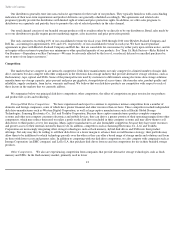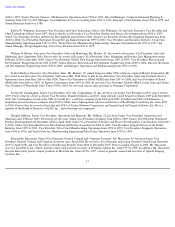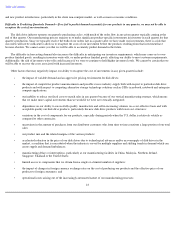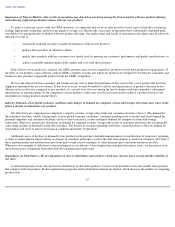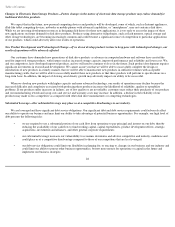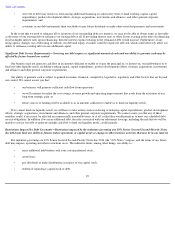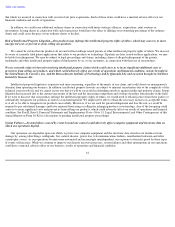Seagate 2009 Annual Report Download - page 24
Download and view the complete annual report
Please find page 24 of the 2009 Seagate annual report below. You can navigate through the pages in the report by either clicking on the pages listed below, or by using the keyword search tool below to find specific information within the annual report.
Table of Contents
of those products. Accordingly, we cannot accurately determine the ultimate effect that our new products will have on our results of operations.
In addition, the success of our new product introductions is dependent upon our ability to qualify as a primary source of supply with our
OEM customers. In order for our products to be considered by our customers for qualification, we must be among the leaders in time-to-market
with those new products. Once a product is accepted for qualification testing, any failure or delay in the qualification process or a requirement
that we requalify can result in our losing sales to that customer until new products are introduced. The limited number of high-volume
OEMs magnifies the effect of missing a product qualification opportunity. These risks are further magnified because we expect competitive
pressures to result in declining sales, eroding prices, and declining gross margins on our current generation products. We cannot assure that we
will be among the leaders in time-to-
market with new products or that we will be able to successfully qualify new products with our customers in
the future. If we cannot successfully deliver competitive products, our future results of operations may be adversely affected.
Smaller Form Factor Disk Drives
—If we do not continue to successfully market smaller form factor disk drives, our business may suffer.
The disk drive industry is experiencing significant increases in sales of smaller form factor disk drives for an expanding number of
applications, in particular notebook computers and consumer electronic devices, but also in personal computers and enterprise storage
applications. Our future success will depend on our ability to develop and introduce smaller form factor drives at desired price and capacity
points faster than our competitors.
We have experienced competition from other companies that produce alternative storage technologies like solid state or flash memory,
where increased capacity, improving cost, lower power consumption and performance ruggedness have resulted in flash memory largely
replacing disk drives in handheld applications. We believe that the demand for disk drives to store or back up related media content from such
handheld devices, however, continues to grow. While this competition has traditionally been limited to the markets for handheld consumer
electronics applications, these competitors have announced SSDs for netbook, notebook and enterprise compute applications.
If we do not suitably adapt our product offerings to successfully introduce additional smaller form factor disk drives or alternative storage
products based on flash storage technology, or if our competitors are successful in achieving customer acceptance of SSD products for netbook,
notebook and enterprise compute applications, then our customers may decrease the amounts of our products that they purchase, which would
adversely affect our results of operations.
Seasonality
—Because we experience seasonality in the sales of our products, our results of operations will generally be adversely impacted
during the second half of our fiscal year.
Sales of computer systems, storage subsystems and consumer electronics tend to be seasonal, and therefore we expect to continue to
experience seasonality in our business as we respond to variations in our customers' demand for disk drives. In particular, we anticipate that sales
of our products will continue to be lower during the second half of our fiscal year. In the client compute and client non-compute market
applications of our business, this seasonality is partially attributable to the historical trend in our results derived from our customers' increased
sales of desktop computers, notebook computers, and consumer electronics during the back-to-school and winter holiday season. In the
enterprise market our sales are seasonal because of the capital budgeting and purchasing cycles of our end users. Since our working capital needs
peak during periods in which we are increasing production in anticipation of orders that have not yet been received, our results of operations will
fluctuate seasonally even if the forecasted demand for our products proves accurate. Furthermore, it is difficult for us to evaluate the degree to
which this seasonality may affect our business in future periods because of the rate and unpredictability of product transitions
22


